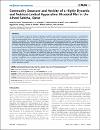Community structure and activity of a highly dynamic and nutrient-limited hypersaline microbial mat in Um Alhool Sabkha, Qatar
| Author | Al-Thani, Roda |
| Author | Al-Najjar, Mohammad A.A. |
| Author | Al-Raei, Abdul Munem |
| Author | Ferdelman, Tim |
| Author | Thang, Nguyen M. |
| Author | Al Shaikh, Ismail |
| Author | Al-Ansi, Mehsin |
| Author | de Beer, Dirk |
| Available date | 2016-03-20T11:22:55Z |
| Publication Date | 2014-03 |
| Publication Name | PLoS ONE |
| Resource | Scopus |
| Citation | Al-Thani R, Al-Najjar MAA, Al-Raei AM, Ferdelman T, Thang NM, Shaikh IA, et al. (2014) "Community Structure and Activity of a Highly Dynamic and Nutrient-Limited Hypersaline Microbial Mat in Um Alhool Sabkha, Qatar". PLoS ONE 9(3): e92405. |
| ISSN | 1932-6203 |
| Abstract | The Um Alhool area in Qatar is a dynamic evaporative ecosystem that receives seawater from below as it is surrounded by sand dunes. We investigated the chemical composition, the microbial activity and biodiversity of the four main layers (L1-L4) in the photosynthetic mats. Chlorophyll a (Chl a) concentration and distribution (measured by HPLC and hyperspectral imaging, respectively), the phycocyanin distribution (scanned with hyperspectral imaging), oxygenic photosynthesis (determined by microsensor), and the abundance of photosynthetic microorganisms (from 16S and 18S rRNA sequencing) decreased with depth in the euphotic layer (L1). Incident irradiance exponentially attenuated in the same zone reaching 1% at 1.7-mm depth. Proteobacteria dominated all layers of the mat (24%-42% of the identified bacteria). Anoxygenic photosynthetic bacteria (dominated by Chloroflexus) were most abundant in the third red layer of the mat (L3), evidenced by the spectral signature of Bacteriochlorophyll as well as by sequencing. The deep, black layer (L4) was dominated by sulfate reducing bacteria belonging to the Deltaproteobacteria, which were responsible for high sulfate reduction rates (measured using 35S tracer). Members of Halobacteria were the dominant Archaea in all layers of the mat (92%-97%), whereas Nematodes were the main Eukaryotes (up to 87%). Primary productivity rates of Um Alhool mat were similar to those of other hypersaline microbial mats. However, sulfate reduction rates were relatively low, indicating that oxygenic respiration contributes more to organic material degradation than sulfate reduction, because of bioturbation. Although Um Alhool hypersaline mat is a nutrient-limited ecosystem, it is interestingly dynamic and phylogenetically highly diverse. All its components work in a highly efficient and synchronized way to compensate for the lack of nutrient supply provided during regular inundation periods. |
| Sponsor | Qatar University, fund number QUUG-CAS-BES-11/12-, and Max-Planck Institute for Marine Microbiology. |
| Language | en |
| Publisher | Public Library of Science |
| Subject | Ecosystems Microorganisms Microbial mats |
| Type | Article |
| Issue Number | 3 |
| Volume Number | 9 |
Files in this item
This item appears in the following Collection(s)
-
Biological & Environmental Sciences [791 items ]


